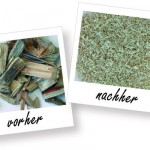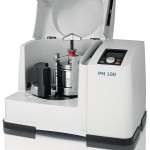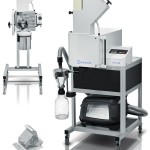A variety of methods can be used to analyse solid materials. What they all have in common is the need to use a representative, homogeneous analysis sample which has to have a particular fineness, depending on the analytical method used. Size reduction and homogenisation of solids is usually carried out with laboratory crushers and grinders.
The author: Dr. Andreas Theisen Team Leader Application Support & Sales Germany, Retsch
One of the most important rules of thumb for size reduction on a laboratory scale is to grind the material as fine as necessary. It is possible to obtain grind sizes of less than 100 nm for many materials by mechanical grinding, although the energy input required to produce particles smaller than 50 µm is very high. As our power supply only provides a defined maximum energy, it cannot be increased at will. Consequently, grind sizes in the nanometre range can only be achieved with very long grinding times of several hours. For routine tasks in a modern quality control laboratory, sample preparation should not take more than a few minutes. Moreover, long grinding times lead to increased abrasion, which could falsify the analysis result. It is therefore advisable to consider the question ‚which fineness is essential to obtain a sample suitable for analysis in the shortest possible time?‘.
In this context, two aspects of the grinding process merit special attention. Firstly, the grinding process serves to homogenise the original material. Secondly, the subsequent sample preparation steps or analysis method may require a certain material fineness. We will take a closer look at these aspects below.
Homogeneity and analytical fineness
With many analysis methods, the amount to be analysed is only a small fraction of the original material, which means that this fraction must represent the complete property set of the sample. If we take a pack of muesli, for example, with a view to determining the energy value, a 1 g sample has to represent the entire contents – including oats, raisins, nuts and dried fruit. No definite particle size has been determined that a sample must have in order to be called homogeneous; however, in practice sizes of around 500 µm have become established.
The term ‚analytical fineness‘ describes the maximum particle size of a sample with which no systematic errors occur in the subsequent analysis. Different analytical methods exist:
- Digestion methods: the solid material is dissolved and burnt before being analysed
- Extraction methods: the components are extracted or evaporated
- Methods involving direct analysis of the solid material
In the case of digestion, the preliminary treatment of the sample is not important, so that the term ‚analytical fineness‘ does not make much sense here. However, care must be taken that the material is not too fine because then the reaction would take place too quickly. This is true, for example, for organic samples which oxidise in the presence of nitric acid. If the material is too coarse, the digestion process takes too long. For these practical reasons, particle sizes of around 500 µm are optimal.
The particle size is of similar relevance for extraction methods. If the powder is too coarse, not everything can be extracted; if the powder is too fine, the extraction thimble is blocked and the material is flushed into the receiver flask. If extraction takes place under pressure, smaller particle sizes of around 200 µm are recommended. The optimum sample fineness strongly depends on the extraction apparatus used. 500 µm is an ideal size for most systems.
If the material is analysed directly using a spectroscopic method, the so-called penetration depth is crucial for the required analytical fineness. The penetration depth is the maximum depth from which the electromagnetic ray can exit from the surface. It is closely correlated to the wavelength. With NMR spectroscopy, the penetration depth is in the order of a metre. With NIR analyses it is about 1 cm and with X-rays around 100 µm. As a general rule, the penetration depth decreases along with the wavelength. The particle size for an NIR analysis should therefore be around 500 µm to ensure that the ray of light completely penetrates the particles. For an XRF analysis, the particle sizes need to be less than 100 µm to guarantee complete penetration.
In summary, it can be said that size reduction of samples down to 500 µm is sufficient for most analysis methods – in terms of homogeneity as well as analytical fineness. For extraction under pressure, the sample may also be finer. It is only vital to obtain particle sizes of less than 100 µm with XRF methods.
From hard to elastic
Retsch offers a great variety of crushers and mills for size reduction and homogenisation of solids upfront of an analysis. Depending on the material properties (e. g. hard, brittle, elastic, fibrous, high oil content etc.), different size reduction principles are applied to grind the sample down to the desired fineness. Hard-brittle materials, for example, are best comminuted with impact and friction, as is the case with a planetary ball mill. Planetary ball mills meet all requirements for fast and reproducible grinding down to a few nanometres. They are used for the most demanding tasks, from routine sample processing to colloidal grinding and advanced materials development. The grinding parameters can be easily selected and saved with a single button. All Retsch planetary ball mills feature a programmable starting time, a power failure backup function with storage of the remaining grinding time and a built-in fan which cools the grinding jars during operation. The comfort grinding jars are dust-tight as well as simple and safe to handle.
For soft and elastic materials, size reduction with a knife or cutting mill is the most suitable method. The Retsch SM 300 cutting mill handles even difficult grinding tasks without any problems. It allows efficient preliminary size reduction of heterogeneous material mixes such as waste or electronic components but can also be used successfully for a vast range of different materials. The mill offers a high level of operational safety and a long service life of the grinding tools. A wide selection of screens, hoppers and collection systems as well as a cyclone-suction combination ensure straightforward adaptation to the individual grinding task. The SM 300 is also available in a special version for heavy-metal-free grinding.
Hall 4.1, Booth J7
cpp-net.com/0212438
Share:











